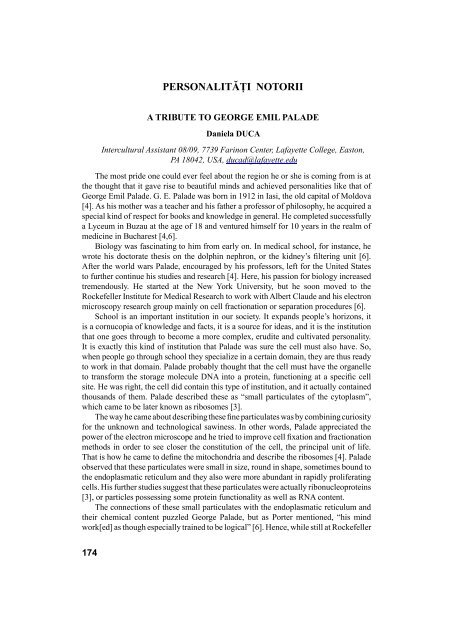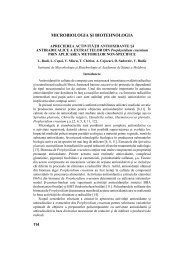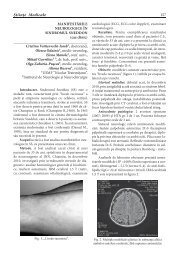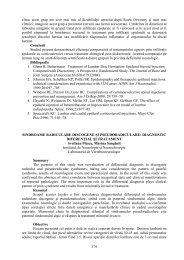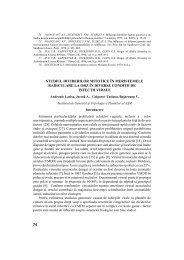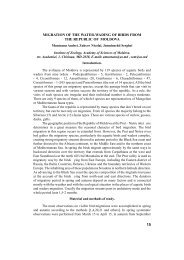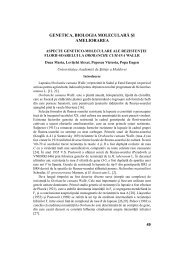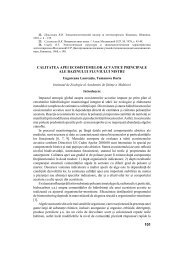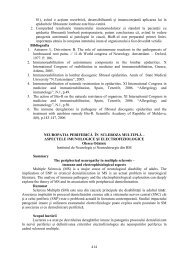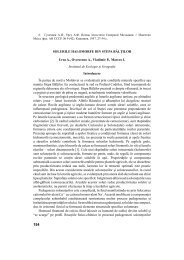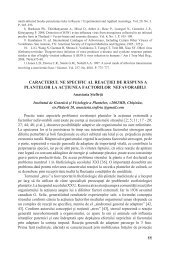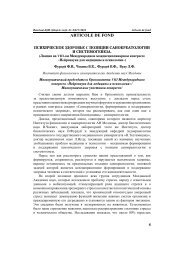198 CUPRINS
198 CUPRINS
198 CUPRINS
You also want an ePaper? Increase the reach of your titles
YUMPU automatically turns print PDFs into web optimized ePapers that Google loves.
174<br />
PERSONALITĂŢI NOTORII<br />
A TRIBUTE TO GEORGE EMIL PALADE<br />
Daniela DUCA<br />
Intercultural Assistant 08/09, 7739 Farinon Center, Lafayette College, Easton,<br />
PA 18042, USA, ducad@lafayette.edu<br />
The most pride one could ever feel about the region he or she is coming from is at<br />
the thought that it gave rise to beautiful minds and achieved personalities like that of<br />
George Emil Palade. G. E. Palade was born in 1912 in Iasi, the old capital of Moldova<br />
[4]. As his mother was a teacher and his father a professor of philosophy, he acquired a<br />
special kind of respect for books and knowledge in general. He completed successfully<br />
a Lyceum in Buzau at the age of 18 and ventured himself for 10 years in the realm of<br />
medicine in Bucharest [4,6].<br />
Biology was fascinating to him from early on. In medical school, for instance, he<br />
wrote his doctorate thesis on the dolphin nephron, or the kidney’s ltering unit [6].<br />
After the world wars Palade, encouraged by his professors, left for the United States<br />
to further continue his studies and research [4]. Here, his passion for biology increased<br />
tremendously. He started at the New York University, but he soon moved to the<br />
Rockefeller Institute for Medical Research to work with Albert Claude and his electron<br />
microscopy research group mainly on cell fractionation or separation procedures [6].<br />
School is an important institution in our society. It expands people’s horizons, it<br />
is a cornucopia of knowledge and facts, it is a source for ideas, and it is the institution<br />
that one goes through to become a more complex, erudite and cultivated personality.<br />
It is exactly this kind of institution that Palade was sure the cell must also have. So,<br />
when people go through school they specialize in a certain domain, they are thus ready<br />
to work in that domain. Palade probably thought that the cell must have the organelle<br />
to transform the storage molecule DNA into a protein, functioning at a speci c cell<br />
site. He was right, the cell did contain this type of institution, and it actually contained<br />
thousands of them. Palade described these as “small particulates of the cytoplasm”,<br />
which came to be later known as ribosomes [3].<br />
The way he came about describing these ne particulates was by combining curiosity<br />
for the unknown and technological sawiness. In other words, Palade appreciated the<br />
power of the electron microscope and he tried to improve cell xation and fractionation<br />
methods in order to see closer the constitution of the cell, the principal unit of life.<br />
That is how he came to de ne the mitochondria and describe the ribosomes [4]. Palade<br />
observed that these particulates were small in size, round in shape, sometimes bound to<br />
the endoplasmatic reticulum and they also were more abundant in rapidly proliferating<br />
cells. His further studies suggest that these particulates were actually ribonucleoproteins<br />
[3], or particles possessing some protein functionality as well as RNA content.<br />
The connections of these small particulates with the endoplasmatic reticulum and<br />
their chemical content puzzled George Palade, but as Porter mentioned, “his mind<br />
work[ed] as though especially trained to be logical” [6]. Hence, while still at Rockefeller


